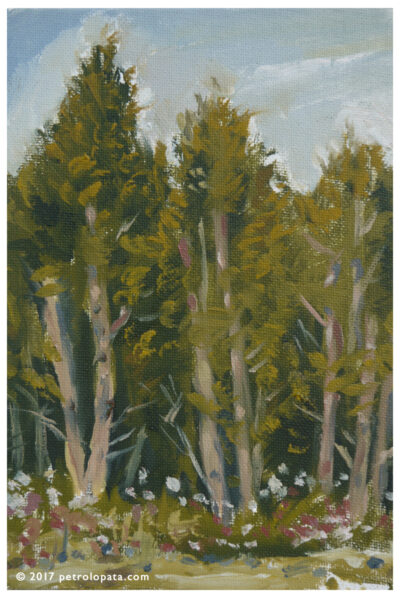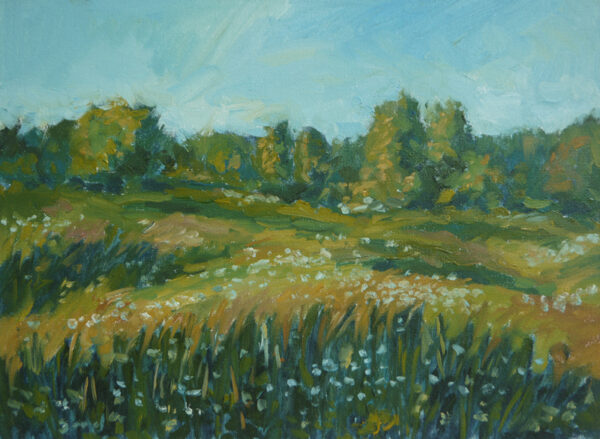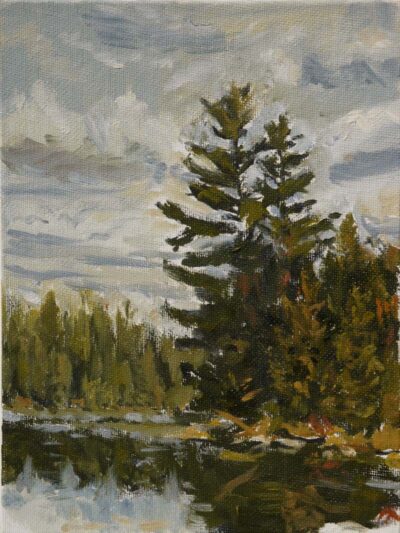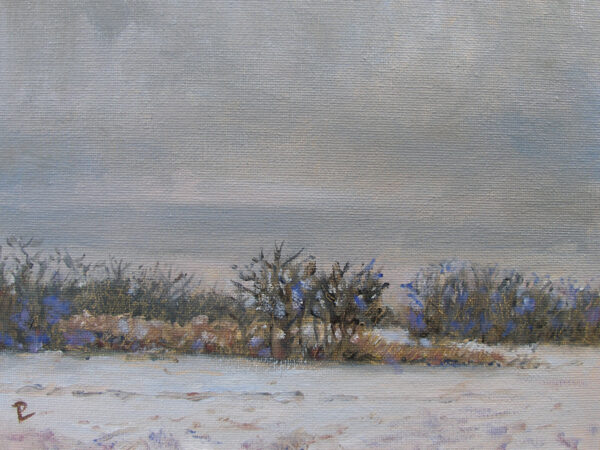
Over the years, I’ve worked in many fields, from logistics and materials handling, newspaper publishing and management, sustainability and recycling, graphic design for print and web, to literally working out on fields as a farmhand. All along this meandering track through diverse industries, I’ve had a strong desire to create art.
My family had a huge and early impact. Our home was filled with art, books and culture. I was extremely privileged that from a young age, my parents (both or taking turns when money was tight) took me to all sorts of cultural events, gallery openings, concerts and festivals, from Toronto’s multicultural International Caravan, to season tickets at the Young People’s Theatre in later grade school.

“Academic Portrait from male model (Bohdan)”: pencil, paper, 24×18″, 1993
Growing up with my father, a young struggling fine artist at the time, I remember visiting the Ontario College of Art where my mom and I would pick him up after his evening classes were finished. Later, I ended up taking part-time night classes at the OCA, just like my father.
My parents have been tremendously supportive and encouraging and I’m fortunate to have learned different aspects of the art field from them, including production techniques and administration.

“Academic Still Life”: pencil, paper, 18×24″, 1992
As a youngster, I was fascinated by the mythology of the Greeks and Romans, tales of King Arthur and his knights, and the fantasies of Tolkien. I got into a phase of doodling dragons and designing elaborate 2-D labyrinths on long reams of folded computer paper.
In high school I did particularly well in my art studies, especially under the guidance of Father McKinnon. Fortunately, I had him as my art teacher twice, in grades 11 and 13. He encouraged his students to really think about the why of making art.

“Autumn Sky”: oil, canvasboard, 5×7″ 2016
All the while, I loved and continue to love looking at the art books in my father’s library, and I remember fondly the ones on Rubens, Rembrandt and Dali, and a series of little hardcovers that examined the Northern and Southern Renaissance Masters from Brueghel to Raphael. Now, the books I own on art are among my most favourite things– them and my brushes.
Having an artist father has led to many shared, memorable experiences: the massive and splendid Van Gogh and Kurelek shows at the Art Gallery Ontario, Corot at the National Gallery in Ottawa, seeing Rembrandt’s Night Watch at the Rijksmuseum in Amsterdam.

“Cedars”: oil, canvasboard, 8×6″, 2003
I was also very lucky to have accompanied my father on the trip for his first solo show in Europe, at the Lviv National Museum in Ukraine, where I met my eventual mentor, friend and landlord for a year, the curator and now late Yurko Boyko.
After a brief stint at the OCA, and unhappy with the pace of my artistic education, I headed out to newly independent Ukraine, to continue my education at the Lviv Ivan Trush College of Art, the only foreign student enrolled.

“Bushes and poplars”: oil, canvasboard, 8×6″, 1999
Yurko Boyko and his wife, the architect Oksana, generously provided me with an immersive extra-curricular education, introducing me to their wide circle of friends, among them the members of the independent art movement known as “Shliakh” or “The Way.”
I even took private lessons with one of its members, the Ukrainian neo-expressionist painter and printmaker Petro Humeniuk, who shared his studio with multi-disciplinary artist and curator Vlod Kaufman.

“Field with Daisies”: oil, canvas, 9×12″, 2003
Another influential figure among the many others I befriended was the outsider artist Myroslaw Jahoda, who suffered from schizophrenia but prolifically painted large canvases of his visions. Due to health complications, I had to return to Canada after three years out of a five-year program.
The courses were rigorous, very technical and based on solid perspective, construction and modeling with tones. We copied from plaster casts of classical statuary, different versions of Venus/Aphrodite. Michelangelo’s “David” was another that was frequently drawn, in different sections and from different angles.

“Jean, My Grandma”: oil, canvas, 10×8, 1997
Later we progressed to drawing and painting from life. Additionally, during the first year, I studied restoration and sculpture.
The former provided me with the rudiments of restoring painting on wood panels, and we got to look at many beautiful Baroque-era and later icons from the museums of western Ukraine. The latter allowed me to think about space and form in new ways and to work with my hands directly in a sensation I can still recall with great joy.

“On the Rocks”: oil, canvasboard, 6×8″, 2003
One of my fellow students sold me a used plein-air box with telescopic aluminium legs and I first started painting outdoors from architecture and landscapes. I still own that box, and thoroughly enjoy the freedom of painting outside with it to this day. Though it’s received a few repairs, it’s still sort of holding together. (More duct tape should do the trick.)
I was lucky to have attended the memorable lecture Jeff Koons gave at the OCA. He offered great insights into the practice of contemporary art.

“Reverie (Raw Umber)”: oil, paper, 4×6″, 2017
In that regard, I highly recommend to all artists and art-lovers any of Don Thompson’s fairly recent books on the business of art. He’s Professor Emeritus at the Schulich School of Business at York University and his analysis is vital to any serious understanding of the art market and how it functions.
In the past, I used to work fast and improvise a lot, without preparatory drawings, mainly painting alla prima. Now, for the most part, in my studio work, I paint more slowly and deliberately, building up glazes of transparent oil colours. This is over a careful monochrome pencil crayon drawing, sealed with a layer of clear acrylic.

“Seated Nude with Auburn Hair”: watercolour, pencil, paper, 19×13″, 1997
This method of protecting the drawing from wet media is one I learned taking private lessons with the great Canadian wildlife painter, Kelly McNeill, who herself studied under Robert Bateman.
In general, I tend to work with a warm palette, preferring the strong earth colors. As of late, I’ve switched to using almost entirely walnut oil as a medium, which I find somewhat cleaner and less malodorous than linseed.

“Western Sky from Hillman Church”: oil, paper, 5×7″ 2018
I’ve been using watercolours since childhood. I only took up acrylics seriously in 2015 after doing some research on its technical advances and after attending a presentation by the respected Canadian abstractionist Bianka Guna at an artist’s co-op I had joined.
She gave a demonstration on all the different kinds of acrylic paints, mediums and grounds now available from one of the largest manufacturers of artists’ paints. The samples were very nice and interesting to experiment with, but I still mostly use oils.

“Pines and Pond”: oil, canvasboard, 8×6″, 2003
Mainly I work in a style straddling impressionism and expressionism with subtle colours, and sometimes veer into abstract territory when the mood takes me, never following any trends from popular media.
Quality of materials and integrity of the final product are of utmost importance to me, so I take care in how I handle my colours and which ones I mix together, using tested and tried methods of oil painting, handed down over the centuries of the medium’s existence.

“Winter Field”: oil, canvasboard, 7×9″, 2020
Besides Ralph Mayer’s “The Artist’s Handbook,” Max Doerner’s “The Materials of the Artist” is a favourite reference, especially the latter, with its “Notes on the Techniques of the Old Masters.”
I’ve been fortunate throughout my life to have been surrounded by talented friends in creative fields, especially music, art, literature, theatre, film and other media. So I now consider myself honoured and blessed among the members of the Arts Society of Kingsville. To see more of my art and information about me, please visit petrolopata.com and follow me on Instagram @petrolopata.
Images provided by Petro Lopata

Interesting article. Congratulations on your work and best wishes for the future.
Wonderfully written, thankyou for sharing your artistic journey with us. Always interesting to hear another artist’s experiences . The path we travel can often be up and down with many turns but each step provides new growth and learning opportunities. Your art has passion and fluidity.
Congratulations Petro!!!
The article is very informative portraying your artistic endeavours. Well done and looking forward for the next Solo!
I am glad to see you found your true calling and the peace and satisfaction that comes with it.
Thank you for this article. Very interesting. Congratulations on your acomplishment! I loved your art pieces.
Impressive work! Your parents are no doubt very proud, as they should be!
Beautiful art, Petro!!! Love your work!!!
Beautiful work Petro! Interesting article. You have had many good art experiences and teachers. Proud to have you in ASK.
Fantastic work! And a wonderful interview/arrticle!
Congratulations Petro! Amazing accomplishment and your work is absolutely stunning!
Congratulations Petro amazing article all the best.
You are SOOOOOOO Talented! So happy for you!!!
Love,
Danya
Seeing your works for the first time was very satisfying. Your heartfelt pieces brought out your expression. Bravo